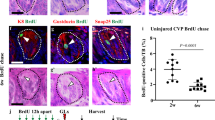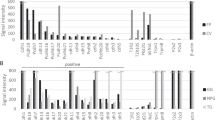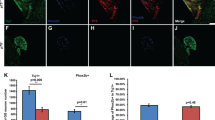Abstract
Fungiform taste papillae form a regular array on the dorsal tongue. Taste buds arise from papilla epithelium1 and, unusually for epithelial derivatives, synapse with neurons, release neurotransmitters and generate receptor and action potentials2,3. Despite the importance of taste as one of our five senses, genetic analyses of taste papilla and bud development are lacking. We demonstrate that Wnt-β-catenin signaling is activated in developing fungiform placodes and taste bud cells. A dominant stabilizing mutation of epithelial β-catenin causes massive overproduction of enlarged fungiform papillae and taste buds. Likewise, genetic deletion of epithelial β-catenin or inhibition of Wnt-β-catenin signaling by ectopic dickkopf1 (Dkk1)4,5,6 blocks initiation of fungiform papilla morphogenesis. Ectopic papillae are innervated in the stabilizing β-catenin mutant, whereas ectopic Dkk1 causes absence of lingual epithelial innervation. Thus, Wnt-β-catenin signaling is critical for fungiform papilla and taste bud development. Altered regulation of this pathway may underlie evolutionary changes in taste papilla patterning.
This is a preview of subscription content, access via your institution
Access options
Subscribe to this journal
Receive 12 print issues and online access
$209.00 per year
only $17.42 per issue
Buy this article
- Purchase on Springer Link
- Instant access to full article PDF
Prices may be subject to local taxes which are calculated during checkout






Similar content being viewed by others
Change history
07 December 2006
In the version of this article initially published online, the label in the lower-left corner of Figure 6b was incorrect. The correct label is 'Act β-catenin'. This error has been corrected for all versions of the article.
References
Stone, L.M., Finger, T.E., Tam, P.P. & Tan, S.S. Taste receptor cells arise from local epithelium, not neurogenic ectoderm. Proc. Natl. Acad. Sci. USA 92, 1916–1920 (1995).
Sugimoto, K. & Teeter, J.H. Voltage-dependent ionic currents in taste receptor cells of the larval tiger salamander. J. Gen. Physiol. 96, 809–834 (1990).
Roper, S. Regenerative impulses in taste cells. Science 220, 1311–1312 (1983).
Zorn, A.M. Wnt signalling: Antagonistic Dickkopfs. Curr. Biol. 11, R592–R595 (2001).
Andl, T., Reddy, S.T., Gaddapara, T. & Millar, S.E. WNT signals are required for the initiation of hair follicle development. Dev. Cell 2, 643–653 (2002).
Chu, E.Y. et al. Canonical WNT signaling promotes mammary placode development and is essential for initiation of mammary gland morphogenesis. Development 131, 4819–4829 (2004).
Hall, J.M., Hooper, J.E. & Finger, T.E. Expression of sonic hedgehog, patched, and Gli1 in developing taste papillae of the mouse. J. Comp. Neurol. 406, 143–155 (1999).
Zhou, Y., Liu, H.X. & Mistretta, C.M. Bone morphogenetic proteins and noggin: Inhibiting and inducing fungiform taste papilla development. Dev. Biol. 297, 198–213 (2006).
Mistretta, C.M. Developmental neurobiology of the taste system. in Taste and Smell in Health and Disease (ed. Getchell, T.V.) 35–64 (Raven, New York, 1991).
Cadigan, K.M. & Liu, Y.I. Wnt signaling: complexity at the surface. J. Cell Sci. 119, 395–402 (2006).
Gat, U., DasGupta, R., Degenstein, L. & Fuchs, E. De novo hair follicle morphogenesis and hair tumors in mice expressing a truncated β-catenin in skin. Cell 95, 605–614 (1998).
Huelsken, J., Vogel, R., Erdmann, B., Cotsarelis, G. & Birchmeier, W. β-catenin controls hair follicle morphogenesis and stem cell differentiation in the skin. Cell 105, 533–545 (2001).
Noramly, S., Freeman, A. & Morgan, B.A. β-catenin signaling can initiate feather bud development. Development 126, 3509–3521 (1999).
Okubo, T., Pevny, L.H. & Hogan, B.L. Sox2 is required for development of taste bud sensory cells. Genes Dev. 20, 2654–2659 (2006).
DasGupta, R. & Fuchs, E. Multiple roles for activated LEF/TCF transcription complexes during hair follicle development and differentiation. Development 126, 4557–4568 (1999).
Hedgepeth, C.M. et al. Activation of the Wnt signaling pathway: a molecular mechanism for lithium action. Dev. Biol. 185, 82–91 (1997).
Harada, N. et al. Intestinal polyposis in mice with a dominant stable mutation of the β-catenin gene. EMBO J. 18, 5931–5942 (1999).
Andl, T. et al. Epithelial Bmpr1a regulates differentiation and proliferation in postnatal hair follicles and is essential for tooth development. Development 131, 2257–2268 (2004).
Byrne, C., Tainsky, M. & Fuchs, E. Programming gene expression in developing epidermis. Development 120, 2369–2383 (1994).
Soriano, P. Generalized lacZ expression with the ROSA26 Cre reporter strain. Nat. Genet. 21, 70–71 (1999).
Miura, H. et al. Co-expression pattern of Shh with Prox1 and that of Nkx2.2 with Mash1 in mouse taste bud. Gene Expr. Patterns 3, 427–430 (2003).
Zhang, G.H., Deng, S.P., Li, L.L. & Li, H.T. Developmental change of α-gustducin expression in the mouse fungiform papilla. Anat. Embryol. (Berl.), published online 25 August 2006 (doi: 10.1007/s00429–006–0112–2).
Brault, V. et al. Inactivation of the β-catenin gene by Wnt1-Cre-mediated deletion results in dramatic brain malformation and failure of craniofacial development. Development 128, 1253–1264 (2001).
Northcutt, R.G. & Barlow, L.A. Amphibians provide new insights into taste-bud development. Trends Neurosci. 21, 38–43 (1998).
Mbiene, J.P. & Mistretta, C.M. Initial innervation of embryonic rat tongue and developing taste papillae: nerves follow distinctive and spatially restricted pathways. Acta Anat. 160, 139–158 (1997).
Fritzsch, B., Sarai, P.A., Barbacid, M. & Silos-Santiago, I. Mice with a targeted disruption of the neurotrophin receptor trkB lose their gustatory ganglion cells early but do develop taste buds. Int. J. Dev. Neurosci. 15, 563–576 (1997).
Jiang, T.X. et al. Integument pattern formation involves genetic and epigenetic controls: feather arrays simulated by digital hormone models. Int. J. Dev. Biol. 48, 117–135 (2004).
Barlow, L.A. & Northcutt, R.G. Taste buds develop autonomously from endoderm without induction by cephalic neural crest or paraxial mesoderm. Development 124, 949–957 (1997).
Parker, M.A., Bell, M.L. & Barlow, L.A. Cell contact-dependent mechanisms specify taste bud pattern during a critical period early in embryonic development. Dev. Dyn. 230, 630–642 (2004).
Johnson, K.R. et al. P- and E-cadherin are in separate complexes in cells expressing both cadherins. Exp. Cell Res. 207, 252–260 (1993).
Acknowledgements
We thank E. Fuchs (Rockefeller University) for Tg(Fos-lacZ)34Efu reporter mice, A. Glick (Penn State University) for KRT5-rtTA mice, L. Ash for histology and M. Wright and C. Liggins for technical assistance. S.E.M. is supported by US National Institutes of Health grants R01-AR47709 and R01-DE015342, L.A.B. by R01-DC003947, A.A.D. by RO1-AR45973, S.H.Y. by T32-HD007505 and C.L.S.-C. by T32-HL007312. N.M.G. and S.T.R. were supported by T32-AR007465. R.T.M. is an investigator of the Howard Hughes Medical Institute.
Author information
Authors and Affiliations
Contributions
The study was designed by F.L., S.T., N.M.G., L.A.B. and S.E.M. In situ hybridizations were carried out by F.L., S.T. and S.T.R. Immunofluorescence staining was carried out by F.L., S.H.Y. and S.T. X-gal staining was performed by F.L., S.T. and C.L.S.-C. Organ culture experiments were performed by S.T. Ctnnb1(Ex3)fl mice were provided by M.M.T. KRT14-Cre Ctnnb1(Ex3)fl/+ mice were generated by F.L., S.T., S.H.Y. and A.A.D. KRT5-rtTA tetO-Dkk1 mice were generated by F.L. and T.A. KRT14-Cre Ctnnb1fl/fl mice were generated by N.M.G. and F.L. F.L. and N.M.G. performed scanning electron microscopy analyses. R.T.M. was involved in study design and discussion of results. The manuscript was written by F.L., R.T.M., L.A.B. and S.E.M.
Corresponding authors
Ethics declarations
Competing interests
The authors declare no competing financial interests.
Supplementary information
Supplementary Fig. 1
Wnt genes are expressed in embryonic tongue epithelium. (PDF 1083 kb)
Supplementary Fig. 2
K14-Cre is active in tongue epithelium by E12.5 (PDF 511 kb)
Supplementary Fig. 3
Expression of Bmp4 is elevated in K14-Cre Ctnnb1lox(ex3) tongue epithelium compared with control littermate tongue epithelium at E18.5. (PDF 1053 kb)
Supplementary Fig. 4
Wnt and β-catenin signaling is required for expression of fungiform placode markers. (PDF 1833 kb)
Supplementary Table 1
Primers used for genotyping gene-targeted and transgenic mice. (PDF 43 kb)
Rights and permissions
About this article
Cite this article
Liu, F., Thirumangalathu, S., Gallant, N. et al. Wnt-β-catenin signaling initiates taste papilla development. Nat Genet 39, 106–112 (2007). https://doi.org/10.1038/ng1932
Received:
Accepted:
Published:
Issue Date:
DOI: https://doi.org/10.1038/ng1932
This article is cited by
-
Receptome profiling identifies KREMEN1 and ASGR1 as alternative functional receptors of SARS-CoV-2
Cell Research (2022)
-
METTL3-mediated m6A RNA methylation regulates dorsal lingual epithelium homeostasis
International Journal of Oral Science (2022)
-
Taste perception and lifestyle: insights from phenotype and genome data among Africans and Asians
European Journal of Human Genetics (2021)
-
Obesity-induced taste dysfunction, and its implications for dietary intake
International Journal of Obesity (2021)
-
Implications of the specific localization of YAP signaling on the epithelial patterning of circumvallate papilla
Journal of Molecular Histology (2021)



